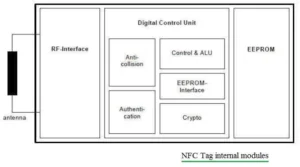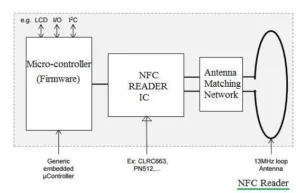Table of Contents
ToggleIntroduction Exploring the NFC Landscape
The dynamic field of Near Field Communication (NFC) has brought about a substantial shift in wireless connectivity, particularly in close-proximity transactions and data exchange. At its foundation, this technology is spearheaded by two critical components: the NFC tag and the NFC reader. These elements interact within a network, defined by their respective roles as the ‘initiator’ and ‘target.’
Active and Passive NFC Modes
An NFC network’s architecture permits two primary modes of operation: active and passive. In the active mode, both the initiating and target devices are independently powered, often through an internal battery source. Passive mode, conversely, denotes a network where one device, usually the reader, is actively powered, while the tag is passive, deriving its operational energy from the active device. This passive operation relies on electromagnetic induction for power and data transfer.

Internal Mechanics of the NFC Tag
The NFC tag, which can exist as either an active or passive entity, forms the bedrock for various NFC-based applications due to its embedded components. It boasts a processor or microcontroller to apportion tasks within its system, an EEPROM to store data, algorithms to prevent signal collision, and cryptographic features that maintain security in communications. This complex yet compact device operates by modulating data onto a 13.56MHz RF carrier wave, facilitated by its internal RF interface circuit and loop antenna designed explicitly for this frequency.
Utilizing Different NFC Tag Types
Adaptability is one of NFC tags’ greatest strengths, emphasized by their categorization into five distinct types – Type 1 through Type 5, each possessing a unique set of characteristics:
- Type 1 tags offer a basic level of functionality, typically read/write capabilities, and a modest memory capacity.
- Type 2 tags increase storage space and provide faster operations, making them suitable for a wider array of applications.
- Type 3 tags commonly associate with more complex systems, integrating additional security features.
- Type 4 tags are characteristic of being highly flexible in terms of security and memory size, which can be extensive.
- Type 5 tags, such as the Mifare Classic tag, are known for their proprietary technologies, offering distinct advantages for specific use-cases.
Selection parameters of NFC tags generally encompass their active/passive nature, memory capacity, operational speed, data access methods, collision algorithms, and pricing.

The NFC Reader: A Closer Look
Prevailing as the active device in the NFC equation, the NFC reader is the interrogation tool that interprets and processes the signals from tags. Its sophisticated blueprint includes:
- A powerful microcontroller, usually from the LPC series
- A dedicated NFC reader IC provided by manufacturers such as NXP Semiconductors
- An antenna matching circuit fine-tuned for the 13.56MHz operational frequency
- A loop antenna purpose-built to interact within the NFC spectrum
NFC readers are stocked with an array of host interfaces extending from SPI and I2C to RS232 and UART, and their design usually includes EEPROM to facilitate the storage of NFC protocols and a FIFO buffer to adeptly handle the transmission and reception of data frames.

Conclusion Navigating NFC Choices for Your Needs
In the burgeoning expanse of NFC technology, appreciating the functional differences between tags and readers is paramount. More importantly, understanding the nuanced capabilities within various tag types can empower users to align NFC components with the precise demands of their applications, paving the way for optimized interactions and streamlined workflows in a world that’s steadily embracing touchless connectivity.
